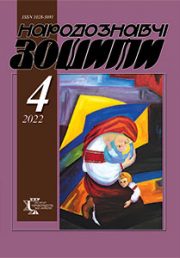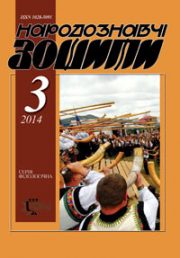The Ethnology Notebooks. 2023. № 1 (169), 31—43
UDK [930.2:572](477)”1920/1930″
DOI https://doi.org/10.15407/nz2023.01.031
DEVELOPMENT OF UKRAINIAN ANTHROPOLOGY IN THE 20—30 YEARS OF THE XX CENTURY. ACHIEVEMENTS AND LOSSES
SEGEDA Sergij
- ORCID ID http://orcid.org/0000-0001-6772-8387
- Doctor of Sciences in History, Lead Researcher
- of the Institute of Ethnology of the National Academy
- of Scienses of Ukraine,
- in the Department of Historical Ethnology,
- 15, Svobody Avenue, 79000, Lviv, Ukraine,
- Contacts: e-mail: sergij_segeda@ukr.net
Abstract. For the first time in historiography, the author analyzes the current state, methodological principles, and trends of the development of the Ukrainian Physical Anthropology in the 20s and 30s years of the last century, when the territory of Ukraine was a part of the different states.
The relevance of the study is determined by the lack of general studies of this issue.
The purpose of the article is a comparative analysis of the activities of anthropological institutions in Kyiv and Lviv; and a general assessment of the achievements and losses of national Anthropology in the interwar period.
Historical-cultural and comparative-typological methods of ethnological science were mainly used in the process of empirical data analysis.
As a result of the study, it was found that, during the 1920-1930s, there were 3 scientific centers in Ukraine, studying the anthropological composition of the Ukrainians, namely: the Hvedir Vovk Anthropology and Ethnology Office at the All-Ukrainian Academy of Sciences (VUAN) (Kyiv); Taras Shevchenko Scientific Society and the Department of Ethnology and Anthropology of Lviv University (Lviv). The research activities and main results of the leading scientists of these institutions are analyzed, specifically, Anatolii Nosov and Ivan Rakovskyi, who continued research initiated by the founder of Ukrainian Anthropology Hvedir Vovk; the leader of the Lviv anthropology school Jan Chekanovskyi, who, based on his own theoretical approach, developed an original concept of the anthropological composition of the peoples of Europe; Rostyslav Yendyk, who described several zones of the ethnic territory of Ukraine, the population of which differs according to the ratio of the main European anthropological types. It is noted that certain statements of the works of these scientists preserve their scientific significance to this day. Finally, it was found that as a result of repressions and persecutions by the Stalinist regime and the Nazi occupiers, national Physical Anthropology suffered heavy losses: after the Second World War, all 3 centers of this scientific discipline were eliminated, and none of active anthropologists remained on the territory of Ukraine.
Keywords: physical anthropology, anthropological composition of the Ukrainian people, individual-typological method.
Received 3.01.2023
REFERENSES
- Taran, O.G. (1999). Scientific and theoretical activity of the Department of the Hv. Vovk Anthropology and Ethnology at VUAN. VITA ANTIQUA (Pp. 247—250) [in Ukrainian].
- Hlushko, M. (2010). Anthropological studies in the Shevchenko Scientific Society (end of the 19—30-s of the 20th century). Bulletin of Lviv University (Vol. 45, pp. 413—436). Historical series [in Ukrainian].
- Tarnavskyi, R. (2014). The Institute of Anthropology and Ethnology of Lviv University as the basis for the formation of the scientific school of Jan Chekanovskyi. The Ethnological notebooks, 1 (115), 18—28 [in Ukrainian].
- Kashchenko, M.F. (1919). Note to the Commission for drafting a draft law outlining the program for the organization of the Museum of Anthropology and Ethnology at the Ukrainian Academy of Sciences (August 12, 1918). Proceedings of the commission for the development of a bill on the establishment of the Ukrainian National Academy of Sciences in Kyiv (Pp. 23—25). Kyiv: Printing house of the Kyiv Scientific Society [in Ukrainian].
- (1925). Bulletin of the Hv. Vovk Cabinet of Anthropology and Anthropology, 1 [in Ukrainian].
- (1993). History of the Academy of Sciences of Ukraine. 1918—1923. Documents and materials. Kyiv: Naukova dumka [in Ukrainian].
- Ruda, O.Z. (2010). Oleksandr Gavrilovych Alesho (1890—1922) — a scientist and organizer of Ukrainian science (Book 49). Historical and bibliographic series «Agrarian science of Ukraine in persons, documents, bibliography». Kyiv [in Ukrainian].
- Skrypnyk, G.A. (1989). Ethnographic museums of Ukraine. Kyiv: Naukova dumka [in Ukrainian].
- Nosiv, A. (1922). O.G. Alesho (9.II.1890—4.IV.1922)(obituary). Bulletin of agricultural science (Issue 1, pp. 40—42) [in Ukrainian].
- Mykhailova, A.A. (2015). Ethnographic and anthropological expeditions of A.Z. Nosov to the Kingdom of Serbia (1911—1912): results and significance. XI Congress of anthropologists and ethnologists of Russia: collection of materials (Yekaterinburg, July 2—5, 2015) (P. 396). Moscow; Yekaterinburg: IEA RAS; IIA UrO RAN [in Russian].
- Nosov, A.Z. (1924). Anthropological and ethnological study of a person — the population of Ukraine. Red way, 1—2, 136—140 [in Ukrainian].
- Nosiv, An. (1927). Materials for anthropology of Ukraine. Ukrainians of Podillia. Ethnographic Bulletin (Book 5, pp. 94—117). Kyiv [in Ukrainian].
- Nosov, An. (1928). Materials for anthropology of Ukraine. Ukrainians of the Kuban. Anthropology. Yearbook of the Hv. Vovk Department of Anthropology (Vol. 1, 1928, pp. 31—64). Kyiv [in Ukrainian].
- Tkach, M. (1929). Anthropological measurements of the population of the village of Bondarevoi, in the Shevchenkiv region. Anthropology. Hv. Vovk Yearbook of the Department of Anthropology. 1928 (Vol. II, pp. 70—104). Kyiv [in Ukrainian].
- Tkach, M. (1931). Materials for anthropology of Ukraine. Ukrainians of the Shevchenkiv district. Anthropology. Yearbook of the Hv. Vovk Department of Anthropology. 1930 (Vol. IV, pp. 107—147). Kyiv [in Ukrainian].
- Matyushenko, B. (1930). Anthropological characteristics of the Ukrainian people. Prague: Publication of the Ukrainian University in Prague [in Ukrainian].
- Chorna, L.O. (2011). From the cohort of returned names of repressed Ukrainian scientists: Anatoly Zinoviovych Nosiv. Gurdjieff’s historical readings: Collection of scientific works (Vol. 4, pp. 115—117). Cherkasy [in Ukrainian].
- Shevelyov, Yu. (2017). I — me — me… (and all around). Memoirs. 1. In Ukraine. Kharkiv: Publisher Oleksandr Savchuk [in Ukrainian].
- Miller, M.A. (1954). Archeology in the USSR, 12 (Series 1). Studies and materials. Munich: Institute for the Study of History and Culture of the USSR [in Russian].
- Hotsulyak, V.V. (2015). Activities of the Shevchenko Scientific Society in the interwar period. Herald of Cherkasy University (Series «Historical Sciences»), 35 (328), 65—69 [in Ukrainian].
- Franko, O. (1997). Fedir Kindratovych Vovk (1847—1918): Research. Memoirs. Bibliography: To the 150th anniversary of the scientist’s birthday. New York [in Ukrainian].
- Holovatskyi, I. (2004). Ivan Rakovskyi. 1874—1949. Biographical and bibliographic essay, 9 [in Ukrainian].
- Volkov, F. (1916). Anthropological features. Ukrainian people in its past and present (Pp. 427—454). Petrograd [in Russian].
- Rakovsky, I., & Rudenko, S. (1927). View of anthropological relations in the Ukrainian people. Collection of mathematical-naturalistic-medical section of the Shevchenko Scientific Society in Lviv (Vol. XXVI, pp. 204—214) [in Ukrainian].
- Bunak, V. (1932). Neues Material sur Ausanderung anthropologischer Typen unter der Bevolkerung Osteuropas. Zeitschr. fur Morpol. and Anthropol (Bd. XXX, h. 3, pp. 441—541) [in German].
- Vitov, M.V., Mark, K.Yu., & Cheboksarov, N.N. (1959). Ethnic Anthropology of the Eastern Baltic. Proceedings of the Baltic United Complex Expedition. Moscow: Publishing House of the Academy of Sciences of the USSR [in Russian].
- Alekseeva, T.I (1973). Ethnogenesis of Eastern Slavs according to anthropological data. Moscow: Moscow University Publishing House[in Russian].
- Malinowski, A. (1985). Zycie i dzialalnosc Jana Czekanow skiego. Teoria i empiria w polskiej szkole antropologicz nej. W 100-lecie urodzin Jana Czekanowskiego (Pp. 71—77). Poznan [in Polish].
- Czekanowski, J. (1967). Czlowiek w czasie i przestrzeni. Warszawa [in Polish].
- Czekanowski, J. (1956). Sto lat antropologii polskiej. 1856—1956. Osrodek Lwowski. Wroclaw [in Polish].
- Czekanowski, J. (1930). Zarys antropologii Polski (Vol. 13). Lwow [in Polish].
- Yendyk, R. (1930). Analiza kraniologiczna Lwowskiej mogily kozackiej z XVII w. State archive of Lviv region. F. 26. Op. 4. Ref. 257. Lwow [in Polish].
- Tarnavskyi, R. (2016). Department of Ethnology, Lviv University. Classical period: 1910—1947. Lviv: Ivan Franko LNU [in Ukrainian].
- Malinowski, A. (1981). Materialy kraniologiczne z bylego zakladu antropologiczno-etnologocznego UJK we Lwowie. Zrodla do badan biologii i historii populacji slowianskich (Pp. 125—139). Poznan [in Polish].
- Yendyk, R. (1949). Introduction to the racial structure of Ukraine (Part 1). Series «Library of Ukrainian Studies». Munich: Shevchenko Scientific Society [in Ukrainian].
- Segeda, S. (2018). Rostyslav Yendyk as a representative of the Lviv anthropological school. Spheres of Cultures (Vol. XVII, pp. 302—310). Lublin [in Ukrainian].
- Diachenko, V.D. (1965). Anthropological composition of the Ukrainian people. Comparative study of the peoples of the Ukrainian SSR and adjacent territories. Kyiv: Naukova dumka [in Ukrainian].
- Segeda, S. (2021). Historical anthropology of Ukraine. Lviv: The ethnology Institute of NANU [in Ukrainian].
- Bajer, M. (2008). Czekanowscy (Cz. 1). W imperium i w Europie. Forum Akademicki, 5. Retrieved from: https://prenumeruj.forumakademickie.pl/fa/2008/05/ czekanowscy-cz-1-w-imperium-i-w-europie/ (Date of appel: 15.12.22) [in Polish].






